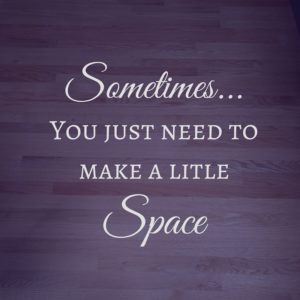 I reorganized my room this past weekend.
I reorganized my room this past weekend.
It wasn’t a project I’d planned, but one thing led to another and suddenly there I was with a tape measure in hand, dreaming of a way to increase my floor space and to make more room for my writing.
That was Friday night.
By the time I went to sleep on Friday I’d reduced the problem from a $5,000+ problem to a $500 problem which only required replacing just a few pieces of furniture and buying some new shelves.
But what I realized when I woke up on Saturday was that I probably didn’t need to acquire any new furniture to make my new dreams a reality… I just needed to be a little more creative with the furniture I already had.
Because here’s the thing — I’ve lived with this same furniture in this same apartment for more than a year and it wasn’t until yesterday that a video opened my eyes to a new vision of my living space.
Having that dream allowed me to believe in the possibility that I could live in my space differently.
For over a year, I’d just tolerated “the way things were” because I couldn’t imagine a better solution.
And once I had, it took me a night of sleeping on it and an hour’s labor to move the furniture around and create a room that feels very different to live in. A room that is much better suited to my needs.
It is not lost on me that this is exactly what we do in coaching — we look at where your ideas about what you are capable of might be narrower than reality or where maybe you are unable to see some new possibility.
We break your rules about how your bed fits into your bedroom and test your unquestioned assumptions about relative dimensions (metaphorically speaking, that is).
We do this so that you can rearrange the furniture of your life and create a new space (a new life) to live in.
I’ve written before about my troubled relationship with rules, and it’s because they cause exactly this kind of perceptual blindness that I both love and hate them.
After all, rules are good — the help us eliminate decision fatigue which makes life simpler and more convenient.
However, rules also have an unfortunate tendency to become artificial limitations on what we believe is possible — exactly the way my bed had become an artificial limitation on how I could use my room because I had assumed (without measuring or verifying!) that it simply wouldn’t fit any other way.
So this week I want to give you permission to dream about the things that aren’t working so well in your home or your life right now. If you had a billion dollars, infinite free time, and a magic wand that could create anything, how would you want those things to be different? What would your ideal solution be?
The trick is to dream without rules or limitations, as much as possible. To really let your creativity run wild.
If you can’t think of anything better, try looking online for inspiration. You might just find your answer is a random video about furniture that transforms seamlessly from a desk into a bed and back again.
Once you’ve hit upon an ideal solution, keep puzzling out ways to downsize it until it’s something that fits within your budget (for time, money, and energy!).
How might you create the ideal effect, but do it unexpectedly?
Perhaps you don’t need a bigger desk in order to create more space for your writing — perhaps you just need to move a nightstand next to your desk so you have more space to store things.
Perhaps you don’t need a smaller bed — you just need to make some measurements and discover that your bed fits in the room in an unforeseen configuration.
Perhaps you discover that you already had everything you needed to make your wildest dreams come true and that the answer has been there all along — wanting only a vision for a better future and a little applied creativity to make it a reality.
After all, as Marie Kondo writes in The Life-Changing Magic of Tidying Up: The Japanese Art of Decluttering and Organizing, “The amount of storage space you have in your room is actually just right. I can’t count how many times people have complained to me that they don’t have enough room, but I have yet to see a house that lacked sufficient storage. Once you learn to choose your belongings properly, you will be left with only the amount that fits perfectly in the space you currently own.”
So, perhaps the answer is just waiting for you to put aside your assumptions and see it.
Much love,
Jessica
Disclaimer: This post contains Amazon affiliate links. I make a (very) small referral commission from purchases made using my links. This does not affect your price.
![By Frode Inge Helland [CC BY-SA 3.0], via Wikimedia Commons](http://jessicaruprecht.com/wp-content/uploads/2016/05/willing-to-wobble-300x300.jpg)